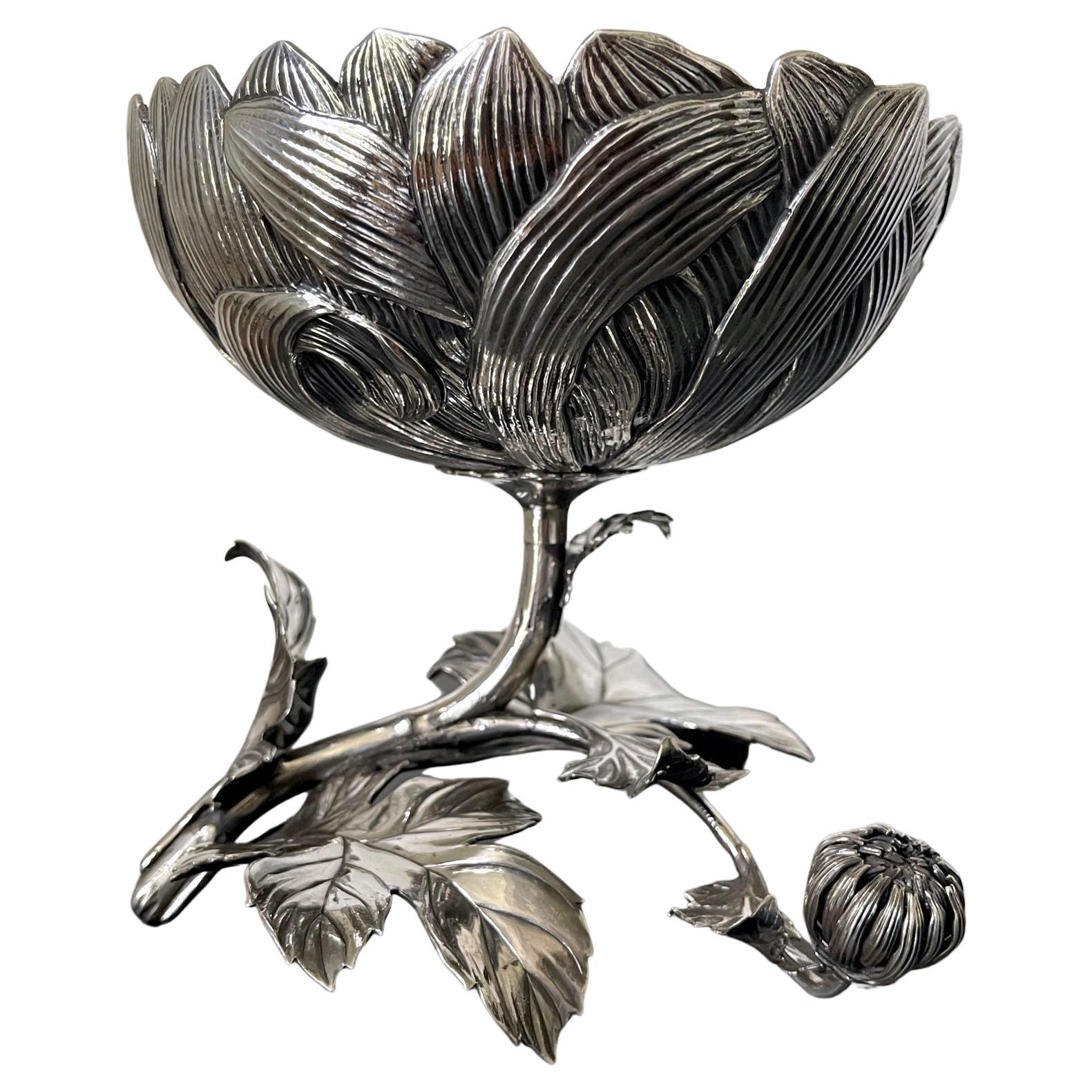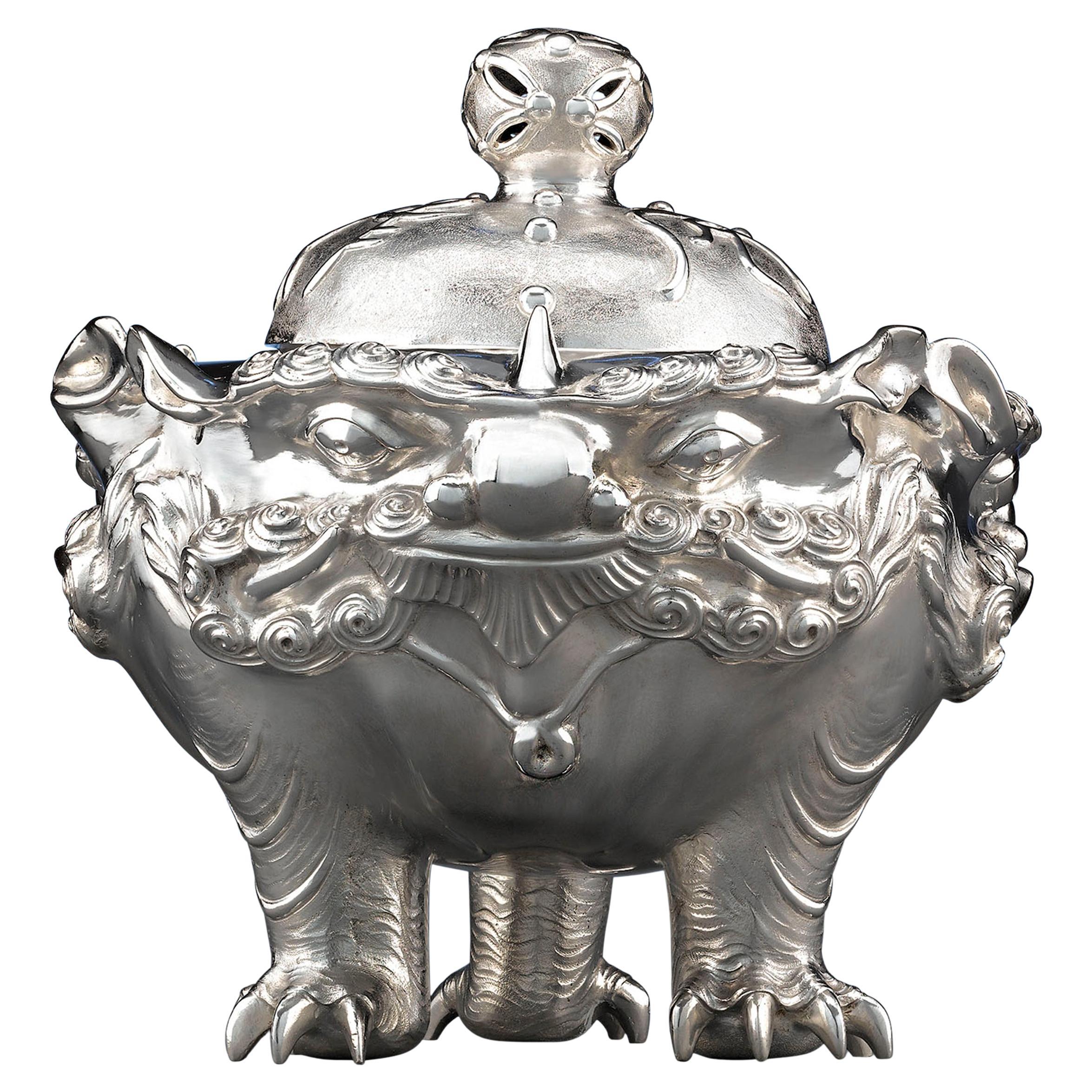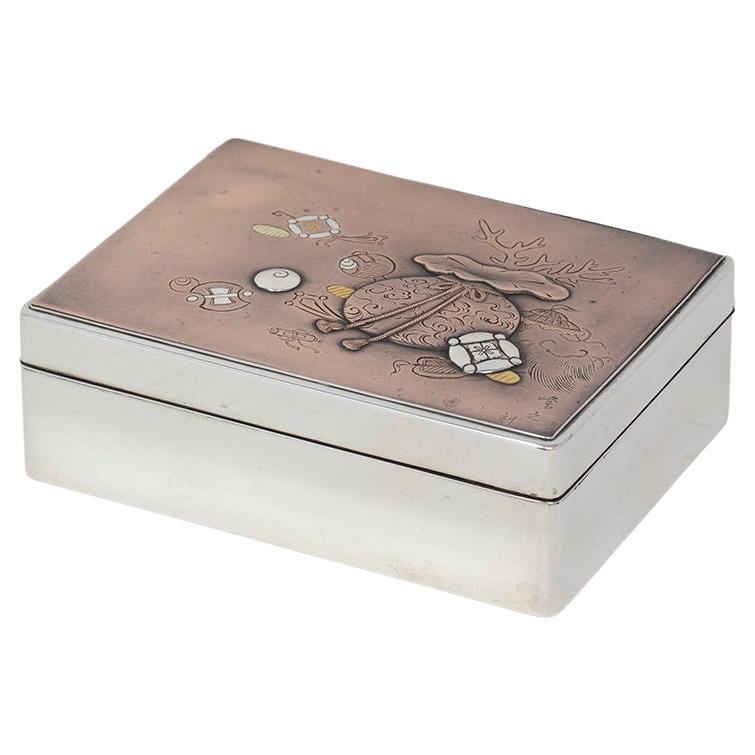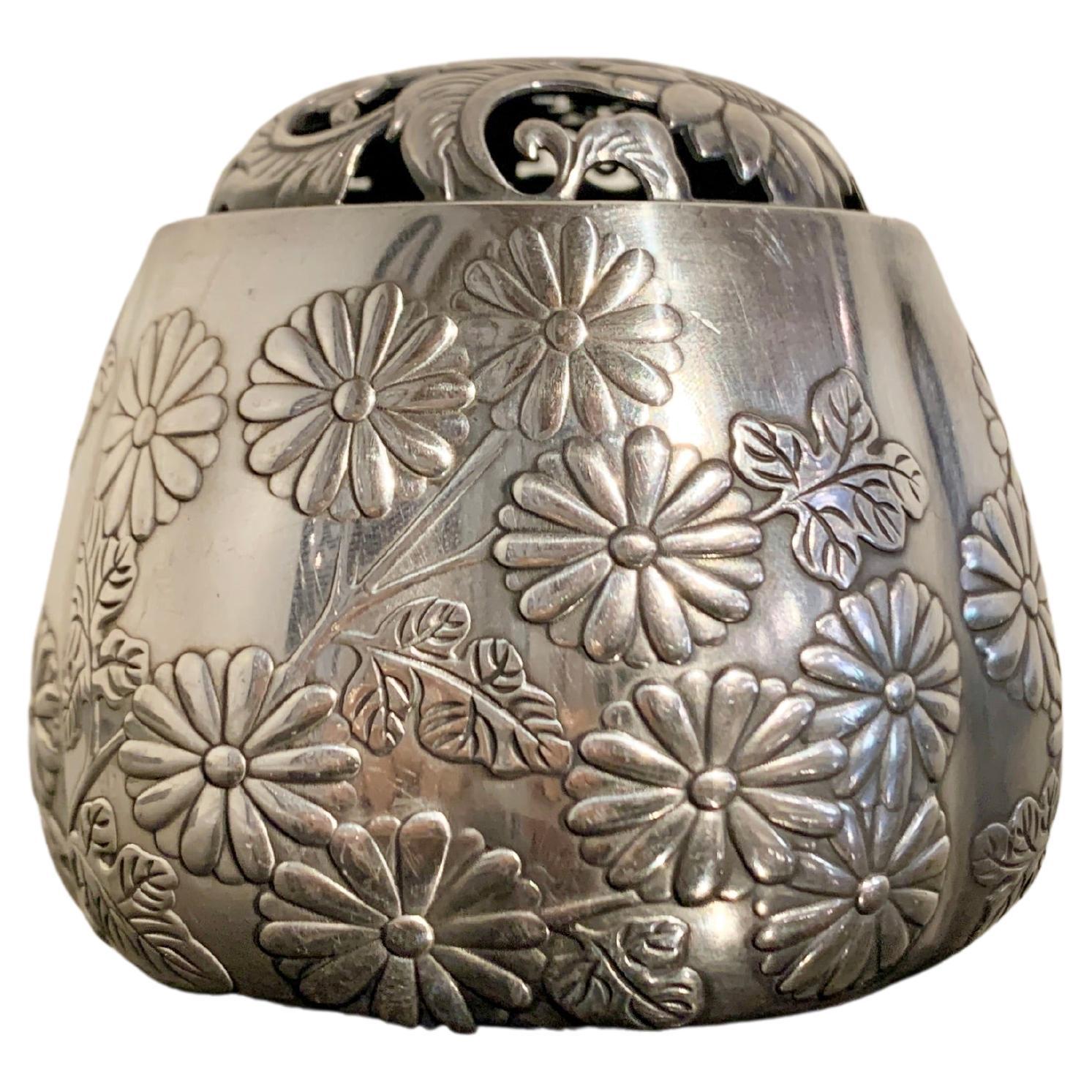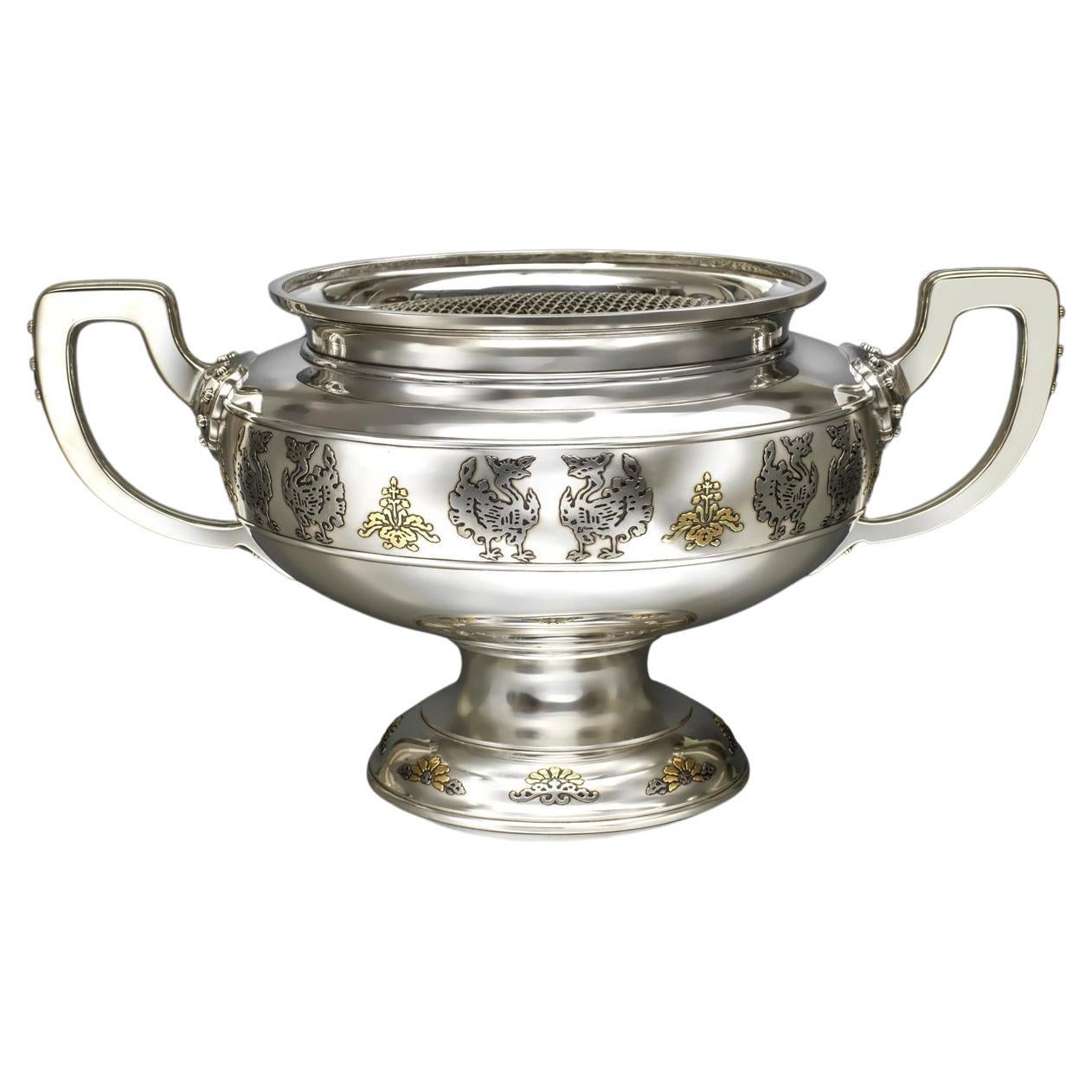Items Similar to Japanese Meiji Period Sterling Silver 2 Handled Basket by Katsu Miyamoto
Want more images or videos?
Request additional images or videos from the seller
1 of 17
Japanese Meiji Period Sterling Silver 2 Handled Basket by Katsu Miyamoto
About the Item
PRESENTING a GORGEOUS, VERY HIGH QUALITY and EXTREMELY RARE piece of Japanese Meiji Period Sterling Silver 2 Handled Basket by Katsu Miyamoto.
EXQUISITE, EXCEPTIONAL, RARE & IMPORTANT!
This is definitely a Meiji Period piece due to the fact that it is marked with the sterling silver mark “jungin”.
The Meiji period was from 1868 to 1912 and in 1928 a law was introduced in Japan compelling the use of decimal marks for silver.
This pre-dates that decimalization law.
We are of the opinion that it is from circa 1900.
Miyamoto Shoko was founded in 1880 as the first silverware specialty shop. In 1899, Miyamoto Shoko’s silverwares were ordered by the family members of the Emperor of Japan, and to this day, they are making fine and graceful handicrafts with skillful craftsmen.
Loved by numerous customers since the Meiji era, Miyamoto Shoko’s products have also been given to Princess Mako and Princess Kako of Akishino, as well as Princess Aiko Toshinomiya, on their birthdays.
Katsu Miyamoto (宮本勝), in 1880, in order to increase the sales of tobacco and cigarettes to foreigners founded the Moyamoto Shoko company, which produced different silverwares in general and particularly silver cigarette cases. Miyamoto’s first name, Katsu (勝) in some sources is written as “Masaru”, since 勝 kanji can be pronounced in both ways.
This basket is of the HIGHEST QUALITY imaginable!
The top of the basket has the MOST GORGEOUS repousse work of flowers, probably lotus flowers, with leaves and foliage. It has an underlying chevron effect chasing, reflecting parquetry.
The 2 handles are cast in the form of bamboo handles.
The rim of the top likewise is cast as bamboo.
The base is equally stunning in a different way!
It is chased with a chevron effect, like parquetry flooring and the four feet simulate pieces of sliced bamboo with an interlinking gallery of support columns, likewise, simulating bamboo.
The QUALITY of WORKMANSHIP is OUTSTANDING!
The pieces weighs exactly 525 grams.
This piece takes my breath away!
This is one for the SERIOUS COLLECTOR of EXQUISITE AND RARE Japanese silver. You will not find another like it, for sale ANYWHERE ELSE IN THE WORLD …… I know as I have searched!
Provenance: Acquired from a Dallas Private Collector.
Dimensions: 9.6 inches wide, 7.6 inches deep and 2.75 inches tall ( 7.25 inches tall with handles up)
Condition: Very good. It looks like the base 4 legged gallery, has been repaired/re-attached to the base, but otherwise it is excellent and of Museum quality.
The Meiji period (明治時代 Meiji-jidai?), also known as the Meiji era, is a Japanese era which extended from October 23, 1868 through July 30, 1912.[1] This period represents the first half of the Empire of Japan during which Japanese society moved from being an isolated feudal society to its modern form. Fundamental changes affected its social structure, internal politics, economy, military, and foreign relations. The period corresponded with the reign of Emperor Meiji after 1868, and lasted until his death in 1912. It was succeeded by the Taishō period upon the accession of Emperor Taishō to the throne.
Solid silver pieces from Japan are VERY RARE…..due to the fact that Japan does not possess a large quantity of silver deposits. Silver was mainly used during the Meiji period to highlight bronze or other pieces and used mainly as inlay for cloisonne work etc….due to its scarcity.
- Creator:Miyamoto Shoko 1 (Maker)
- Dimensions:Height: 7.25 in (18.42 cm)Width: 9.6 in (24.39 cm)Depth: 7.6 in (19.31 cm)
- Style:Meiji (Of the Period)
- Materials and Techniques:Sterling Silver,Repoussé
- Place of Origin:
- Period:
- Date of Manufacture:1900
- Condition:Repaired: Very good. It looks like the 4 legged gallery has been repaired/re-attached to the base, but otherwise it is excellent and of Museum quality. Wear consistent with age and use. Very good original condition.
- Seller Location:Dallas, TX
- Reference Number:1stDibs: LU3978120239172
About the Seller
4.9
Platinum Seller
These expertly vetted sellers are 1stDibs' most experienced sellers and are rated highest by our customers.
Established in 2015
1stDibs seller since 2018
348 sales on 1stDibs
Typical response time: <1 hour
- ShippingRetrieving quote...Ships From: Dallas, TX
- Return PolicyA return for this item may be initiated within 7 days of delivery.
More From This SellerView All
- Japanese Meiji Champleve and Bronze UrnLocated in Dallas, TXPresenting a gorgeous Japanese Meiji Champleve and bronze urn. Made in Japan during the Meiji Period circa 1880. The body of ...Category
Antique Late 19th Century Japanese Meiji Metalwork
MaterialsBronze, Enamel
- 19th Century Sterling Silver Snuffbox Birmingham 1848 by Rolason BrosBy Rolason BrothersLocated in Dallas, TXLovely little sterling silver snuffbox, fully hallmarked with gold plated interior. Lovely chasing on lid and sides, classic high Victorian repousse w...Category
Antique Mid-19th Century English High Victorian Sterling Silver
MaterialsSterling Silver
- Early 20C Etched Crystal Jug with Sterling Silver Base by Arthur A EvertsLocated in Dallas, TXPRESENTING A GORGEOUS piece of DALLAS History, namely, an Early 20C European Etched Crystal Jug with Sterling Silver Base by Arthur A Everts of Dallas. Ci...Category
Early 20th Century American Art Nouveau Crystal Serveware
MaterialsCrystal, Sterling Silver
- Meiji Period High Quality Japanese Bronze Vase by Yoshida ZoLocated in Dallas, TXPRESENTING a GORGEOUS and EXTREMELY RARE Meiji Period High Quality Japanese Bronze Vase by Yoshida Zo. Made in Kyoto, Japan circa 1885, by the famous bronze sculptor, Yoshida Zo. I...Category
Antique Late 19th Century Japanese Archaistic Sculptures and Carvings
MaterialsBrass, Bronze
- Early 20C Pair of Sterling Silver Columbia Weighted CandlesticksLocated in Dallas, TXPRESENTING a LOVELY Early 20C Pair of Sterling Silver Columbia Weighted Candlesticks. Matching pair of 4.5 inch tall candleholders, with fluted baluster central column, on a circular base with repousse edges. Made by the ‘Columbia’ Silver...Category
Early 20th Century American Edwardian Sterling Silver
MaterialsSterling Silver
- Antique Indian Dhokra Horse and Rider SculptureLocated in Dallas, TXPresenting a lovely antique Indian Dhokra horse and rider sculpture. Probably from the late 19th or early 20th century as is evidenced by its natural patina and clear evidence of age. It depicts an Indian Warrior with a sword in his right hand mounted on his horse/steed. The warrior is in classical and ancient Southeast Asian Indian attire and he holds the horse’s reins in his left hand. The body of the horse is a series of lines (in the Classic Dhokra Style) and it has a tribal headdress...Category
Antique Late 19th Century Indian Anglo Raj Metalwork
MaterialsMetal
You May Also Like
- Japanese Sterling Silver Chrysanthemum Dish Meiji PeriodBy MusashiyaLocated in Atlanta, GAAn exquisite Japanese sterling silver ornamental bonbon dish, circa 1890-1900. The piece was rendered in the shape of a stemmed branch of chrysanthemum blossom and was made for export market. Both botanically realistic and stylish, the piece showcases a high degree of artisanal sensitivity and technical ability of the silversmith who created this lovely piece. The petals that form the exteriors were outlined with deep and fluid relief lines of sculptural quality. The branches and leaves were rendered with attentions to the smallest details, with molding and surface texturizing using chasing in contrast with hammering. The interior of the dish is equipped with a conforming inner dish and when it is taken out, revealing the chased lines. The piece, although practical, is basically an okimono in sculptural form, a work of art on its own. It weighs about 22 ounces. Under the dish, it is marked "Pure Silver" in Kanji and SM in a rectangular cartouche. The research (carried out by Adrien Von Ferscht, an expert and author on Asian Export Silver) identified it to be Sadajiro Musashiya...Category
Antique 1890s Japanese Japonisme Metalwork
MaterialsSterling Silver
- Meiji Period Japanese Silver CenserLocated in New Orleans, LAThis stunning Meiji period silver censer is a work of exquisite detail. Crafted by renowned silversmith Masatoshi of Tokyo, the censer, or incense burner...Category
20th Century Japanese Meiji Metalwork
MaterialsSilver
- Japanese Meiji Period Silver Box Signed MasayukiLocated in Newark, EnglandJapanese Meiji period silver box with shibuichi plaque dating circa 1900. The box of rectangular form with a silver polished case stamped Jungin (J...Category
Antique Early 1900s Meiji Metalwork
MaterialsSilver
- Japanese Silver Incense Burner, Akoda Koro, by Norurma, Meiji Period, JapanLocated in Austin, TXA lovely and luxurious Japanese silver incense burner of lobed melon form, akoda koro, marked jungin and signed Nomura, Meiji Period, circa 1900, Japan. The silver koro...Category
Vintage 1910s Japanese Meiji Metalwork
MaterialsSilver, Sterling Silver
- Japanese Silver BowlLocated in London, GBA fine Japanese silver bowl from the Meiji period of traditional double-skin, or double-wall, construction, showing especially detailed irises around...Category
Antique Early 1900s Japanese Meiji Sterling Silver
MaterialsSilver
- Huge Japanese Silver and Mixed Metal Bowl by Miyamoto ShokoLocated in Christchurch, GBAs part of our Japanese works of art collection we are delighted to offer this large and stylish Meiji Period 1868-1912, circa 1900 solid silver and mixed metal bowl by the renowned ...Category
Antique 19th Century Japanese Meiji Metalwork
MaterialsMetal, Silver
Recently Viewed
View AllMore Ways To Browse
Mark And Period
Antique Solid Silver Antiques
Solid Silver Antique
Antique Solid Silver
Japanese Antique Other Japanese Antiques
Antique Japanese Silver
Japanese Antique Silver
Antique Silver Basket
Antique Silver Baskets
Antique Collectors And Period Furniture
Japan Solid
Circa Meiji Japanese
Important Japanese
Japanese Furniture Maker
Japanese Furniture Makers
Antique Japanese Marks
Japanese Antique Marks
Fine Meiji Japan
